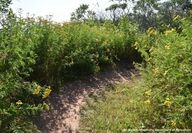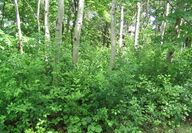Sorted by date Results 1 - 10 of 10

Gardening season is here and after two years in my home I feel motivated to put some time into planting beyond the vegetable garden. But I'm pretty intimidated by all the options: What should I plant? Where should I plant it? Where can I buy it? Will it survive the winter? Will the deer eat it? How tall will it grow? However, I have found some good resources for selecting native and non-invasive plants and preparing the landscape for them to thrive. Simply getting started by trying something...

A shocking number of weed seedlings popped up the first spring of my new garden. If you're planning a garden or landscaping project, consider how the materials you use could bring in invasive species – weeds, seeds, and unwanted pests. Compost can be a huge help to your garden, but the material can also introduce weeds. Most weeds and weed seeds will be killed by the hot composting process – if hot enough for long enough. But not all composting processes or products are the same. If you're pur...

Colorful fall leaves have blown away, but hopefully you got a chance to enjoy the vibrant oranges, yellows, and reds of maple trees. Minnesota has six species of native maples, and some non-native species as well. You may be familiar with the lobed shape of a maple leaf, but on closer inspection each of these seven species' leaves look a little different. Leaf shape is useful to identify species including the non-native and invasive Norway maple. Norway maple is a large shade tree and looks...

It's that time of year again - summer is coming to an end and invasive knotweeds are blooming. In Minnesota, we have three different species of invasive knotweeds: Bohemian knotweed (Polygonum × bohemicum), Giant knotweed (P. sachalinense), and Japanese knotweed (P. cuspidatum and P. cuspidatum var. compacta). While these species do vary a little, they all look pretty similar. Knotweeds can grow to more than 12 feet tall and have large oval to heart-shaped leaves. The green stems resemble...

Summer is a great time to get outside and enjoy the nature we have in Minnesota, and many of us have hobbies that get us into the woods or onto the trails. Think back to the last time you went hiking, horseback riding, biking, camping, ATV riding, or whatever it is you like to do outside – did you remember to clean your equipment, clothes, or pets before heading home or off to your next adventure? It may not be on your radar yet, but invasive plants can be spread accidentally as we r...

Siberian peashrub, Caragana arborescens, was added to Minnesota's Noxious Weed List in 2020. Native to cold climates in eastern Asia, Siberian peashrub can grow up to 18 feet tall and has compound leaves 2-4 inches long with 8-12 pair of leaflets. It produces yellow flowers in May or June which ripen into slender brown seed pods that burst in early fall, dispersing seeds. Seeds may also be dispersed by birds and animals. Often used as an ornamental shrub, windbreak, or wildlife planting,...

On a warm spring day in May, Duluth Cooperative Invasive Species Management Area (CISMA) partners from across south St. Louis County met at a Duluth community center to share their collective knowledge on invasive species causing concern in the region. The group consisted of partners from state agencies, St. Louis County, nearby local governments, local non-profits, homeowners, and volunteers. Shrubs and trees were just beginning to leaf out and green plants were emerging from the soil; a few...

In 2018, the Minnesota Department of Agriculture's (MDA) Noxious Weed Advisory Committee (NWAC) revisited the risk assessment of non-native invasive knotweeds and developed a survey to gather information from the public. Knotweeds typically grow in residential areas – often planted in landscapes – and therefore affect a different group of people and settings than most species on Minnesota's Noxious Weed List. In surveying the public, the NWAC hoped to gain insight on perception and kno...

Minnesota is well loved for forested areas – from expansive tree covered landscapes to wooded city lots. While not all forests in Minnesota have invasive species, they are all susceptible. Invasive plant management tactics may look different depending on the infestation size, location and other factors. We have the opportunity to contribute to invasive species control & protection of our forested landscapes. Invasive plants commonly found in Minnesota forests vary by region – based on dif...

Native to Asia, knotweeds were introduced to North America as an ornamental plant. They can spread into natural areas growing quickly and forming dense monocultures, reducing habitat diversity, and overtaking riverbanks and lakeshores. Additionally, knotweeds have the ability to grow through cracks in pavement or building foundations potentially leading to costly removal of the knotweed and repairs to the structure. In Minnesota two species of knotweed have been identified: Japanese knotweed...